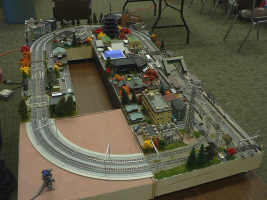
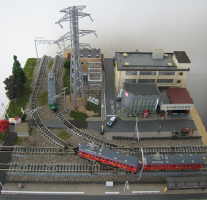
This section provides information, drawings and photos about N-gauge T-Trak modules designed to be especially useful for modeling trolley, streetcar and tram lines in N scale. These "T-Trak for Trolleys" module designs conform to publicly available requirements in design and nomenclature for the popular T-Trak concept, but are specifically designed for trolley operation. By using Tomix track, they can feature tight-radius curves for street corners, end return loops common to streetcar operations using single-end cars like PCC trolleys, and true junction designs. They are fully compatible with regular T-Trak modules, which can be incorporated into a T-Trak for Trolleys layout. Because of the end loops and stub-ended terminal designs, they are not limited to oval-based setups like normal T-Trak modules. They can be used to create prototypical multi-route track networks, as long as the layout design fits on top of tables in T-Trak fashion. These designs conform to the "Alternate" T-Trak design, with 33 mm track spacing. Note that I use metric measurements, since the track is designed and manufactured to metric sizes. I also show approximate overall dimensions in inches. All of these designs have been tested in actual operation.
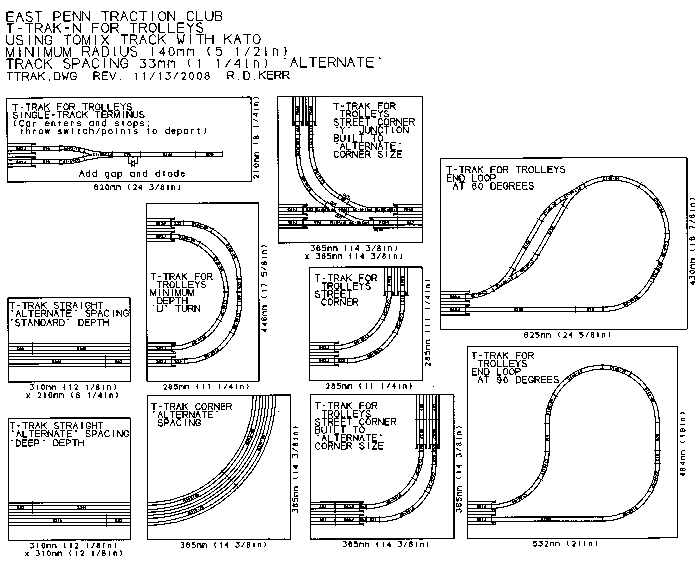
Figure 1: General PDF File - This is a single sheet containing all of the drawings shown in larger scale below. Clicking on this image will bring up the actual PDF file, which can then be saved or printed out.
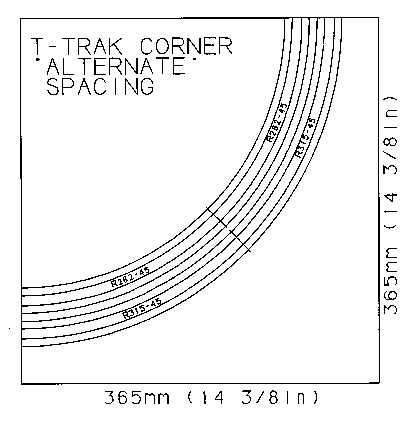
Figure 2: Regular T-Trak Corner Module - Here is the normal T-Trak corner module, using "Alternate" track spacing. It is shown for comparison purposes to the trolley-specific corner designs below. (Also see the first photo above for a contrast in curve radius sizes.)
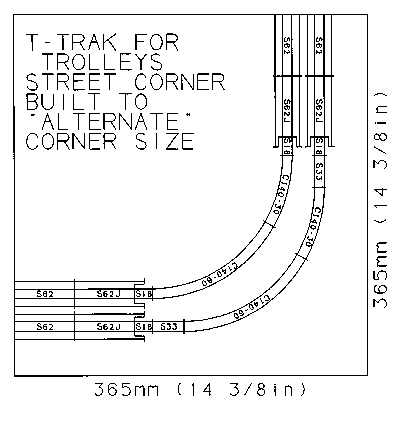
Figure 3: T-Trak for Trolleys Version - Here is a corner module built to the same size as a regular T-Trak "Alternate" corner module, but incorporating a tight corner using Tomix track pieces (the narrow ones) and Kato S62J adapter track sections. Note that two of these modules joined together would provide a reasonable length of straight street between them, making a realistic "city block" look.

Figure 4: Smaller Corner Modules - These two designs have the same curve radius as Figure 3 above, but eliminate unnecessary straight pieces to make the smallest 90-degree and 180-degree corners possible using 140 mm (5.5 inch) radius Tomix track. These would be useful for shelf layouts or elsewhere where space is tight.
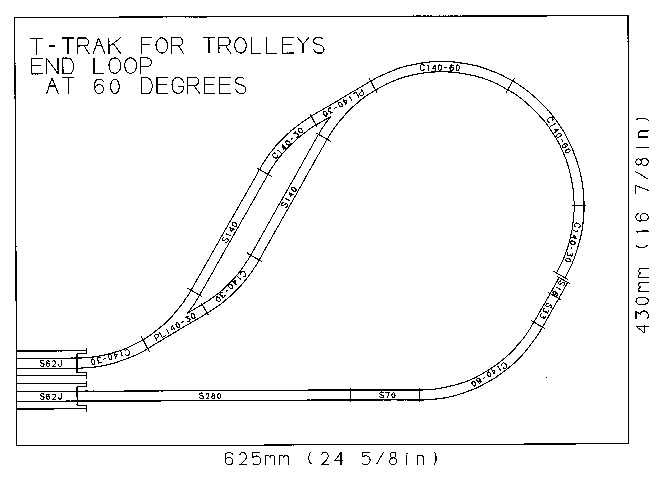
Figure 5: End Return Loop at 60 Degrees - This plan is for a return loop set at an angle. It has two departure tracks if used with right-side operation. The street paving could go straight across the front edge or angle back with the lower track. Do not worry about the apparent misalignment in the drawing; the track pieces are pretty forgiving and all of these designs work fine in actual practice. In the photos below you can see a carbarn added to this module -- feel free to improvise!
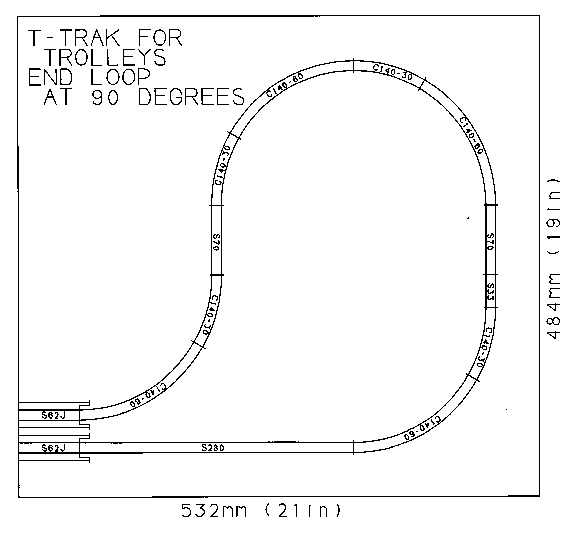
Figure 6: End Return Loop at 90 Degrees - This simple loop could go around a park, small block or wide plaza. In our trial layouts laid out on poster board "modules" this design was flipped in mirror image to form the left end of the setups. The S70 straight track pieces prevent having an immediate "S" curve that can derail coupled multi-car trains.
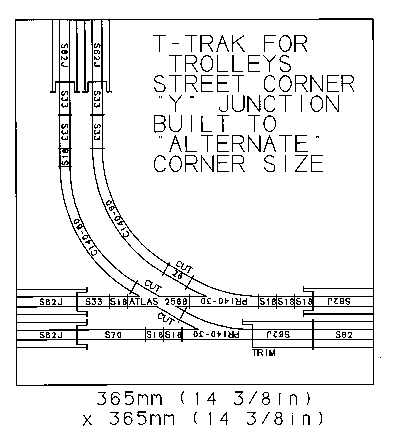
Figure 7: Double-Track Junction - This double track "r"-shaped junction lets a layout split into two routes. It conforms to the size of a regular "Alternate" corner module. It can act as the center of a "T"-shaped or "h"-shaped layout. With a right-handed mate across from it, it could give a traditional T-Trak oval a long-loop and a short-loop option. Note the use of an Atlas 2566 Code 80 30-degree crossing, which is cut to fit, as are one short straight piece and the lip of one adapter track. When I built my trial junction, I actually used cut Snap Track straight track instead of all of the short Tomix pieces, since I had it on hand and it reduced the number of rail joints. Philip Cook's private right-of-way version, the first T-Trak for Trolleys module actually built, is shown in the photos at the top of this page.
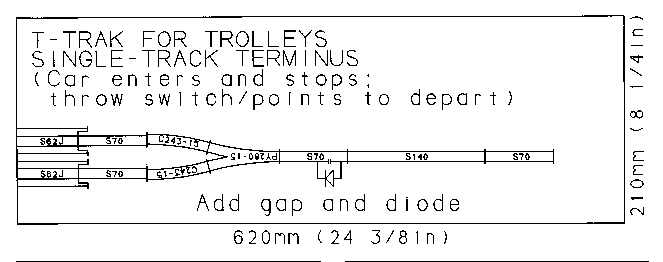
Figure 8: Single Track Stub Terminus - Here is a terminal that is not a return loop. It is a single track end-of-line. It requires that someone operate it, sending cars back out. The operation is made easier, however, by using a rail gap bridged by a diode. Throw the points/turnout to allow entry into the single track and the car will automatically stop after all wheels pass the gap. Then, throwing the Tomix "Y" points/turnout for departure reverses the polarity to the single track and the car will leave. Then reset to allow entry of the next car (without causing a short circuit). Since this is all controlled simply by throwing the points/turnout, it could be done remotely with electric control, perhaps by the same operator who sits at the junction managing traffic there.
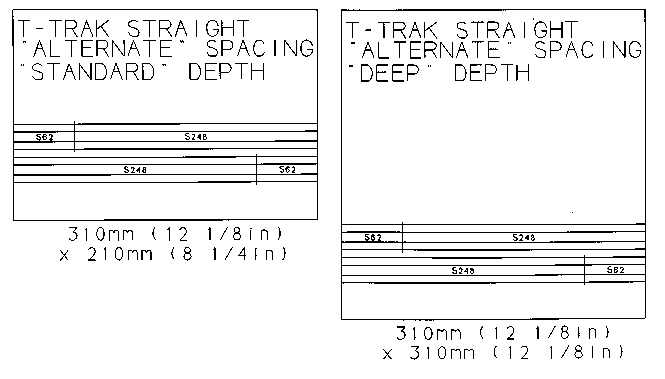
Figure 9: Regular T-Trak Straight Modules - These typical "Alternate" T-Trak modules are shown here just for reference, since regular T-Trak modules can be used with special T-Trak for Trolleys modules. All of these drawings are formatted to the same approximate scale, so you can print out this page, cut the modules out and assemble layout mockups. My understanding is that the straight T-Trak modules generally are built in "Standard," "Deep" and "Deeper" sizes.
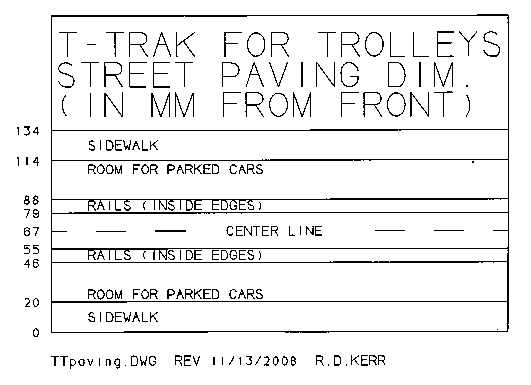
Figure 10: Street and Sidewalk Dimensions - This drawing shows only the tops of the rails, as they would appear paved in a street with sidewalks on both sides, with room for parked cars on both sides. The dimensions are suggested for uniformity, and they are derived directly from the standard T-Trak setback of the tracks from the front edge of the module. Even a module of "Standard" 210 mm (8 1/4 inches) depth will have enough room at the back for buildings.
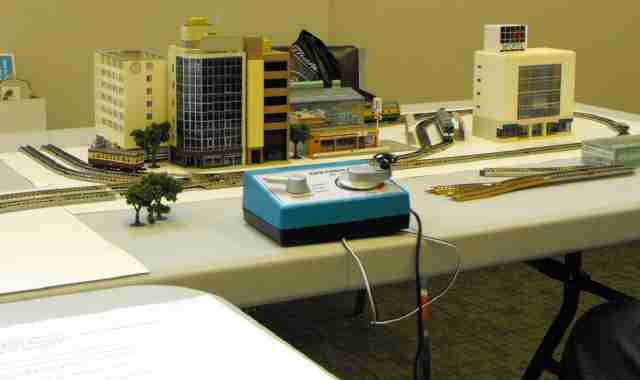
A photo from a trial setup in November 2008, using poster board to represent the modules, shows the junction and 60-degree end loop, with carbarn. (Griffin Tall photo)
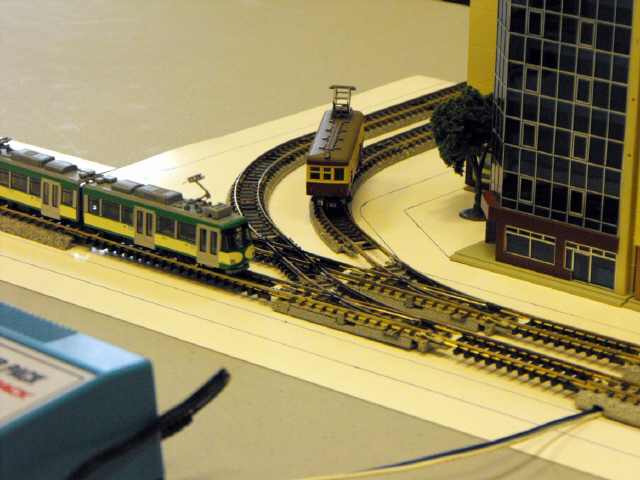
Here is a detail shot of the trackage on the junction module. It also shows the street and sidewalk drawn out on the poster board. (Griffin Tall photo)
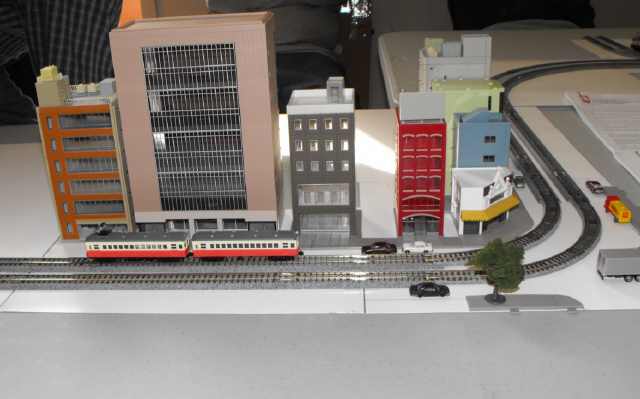
This photo shows the mockup of street straight and street corner modules. Inked lines and some Tomix sidewalk pieces, along with parked cars and some trees, give an indication of how the final paved scene would appear. The curve in the rear is a regular "Alternate" T-Trak corner size.(Griffin Tall photo)
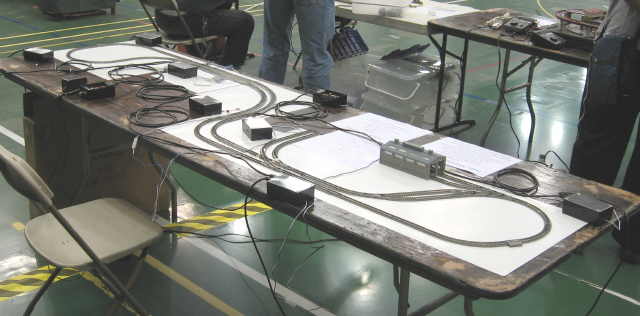
A mockup layout was also displayed at the 2009 East Penn Traction Club's National Trolley Meet, alongside other T-Trak and EasyTrolley layouts in N-gauge. The black boxes around the layout comprise a modular automatic block system, devised by Hiroshi Yagyu of Japan. One power supply/throttle box and eight block control boxes enabled four trolleys to operate automatically in a generally smooth manner on this layout. On a layout with actual T-Trak modules, the boxes and cables would be tucked underneath the modules.
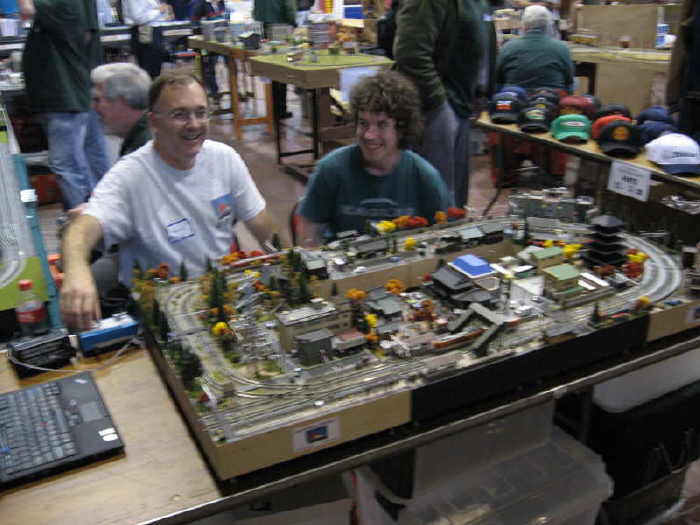
The 2010 New Brunswick (NJ) Rapid Transit and Trolley Modeler's Meet, where three trolley-themed T-Trak layouts and the EasyTrolley layout were displayed. Here Philip and Scott enjoy Philip's intensely-sceniced layout. His original T-Trak for Trolleys module, a double-track junction which also appears at the top of this page, has now been joined by a second T-Trak for Trolleys module.
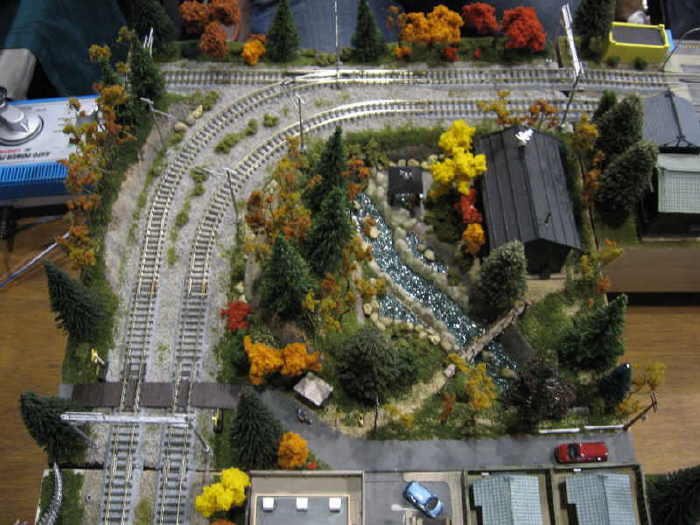
This is a detailed photo of Philip's Japan-based module, a corner module featuring Tomix track and a single junction track. The single track will lead to a terminal on another module. Can you spot the monkeys on this module?
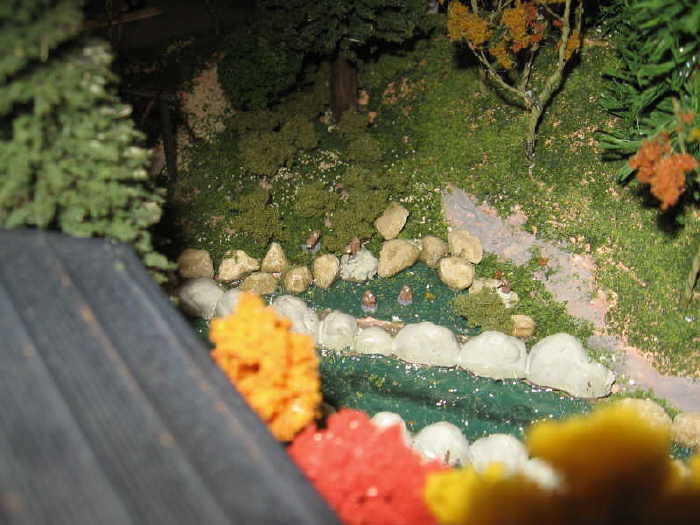
Now can you spot the monkeys?
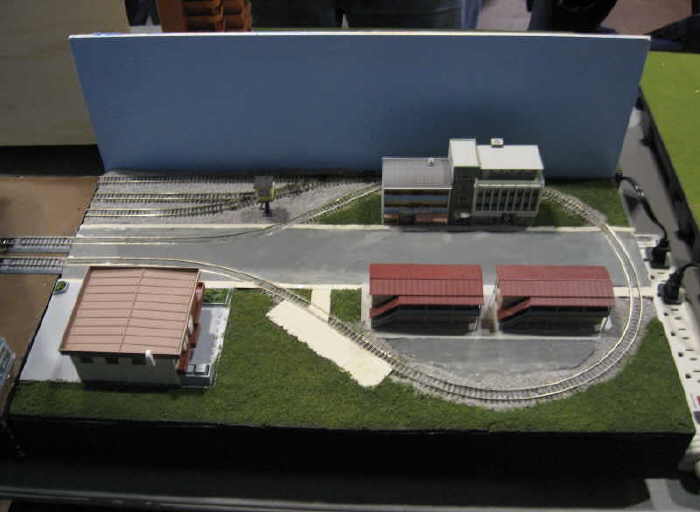
This is another new T-Trak for Trolleys module, by Matt. It's a basic end loop with a yard. Matt used flex track for the loop itself. Like his second loop (hidden behind the skyboard), its depth including skyboard equals that of a T-Trak "alternate" spacing corner module, so the layout can form a "U" shape and fit within the width of a table.
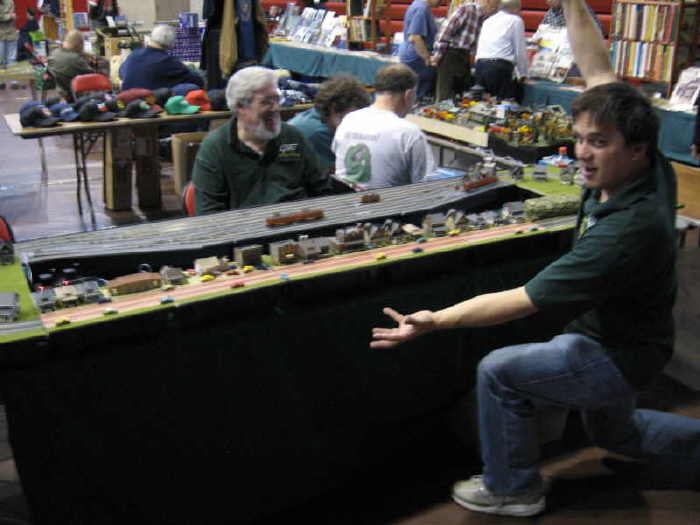
Ed and Matt clown around at Ed's T-Trak layout. The front straight modules feature street trackage, with brick streets made from adhesive-backed brick paper. The rear is a "six-wide" yard module, with GHB International's N-gauge double-truck Birney running through it. Ed uses his modules for both trains and trolleys.